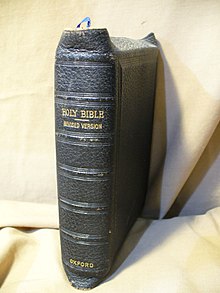Revised Version
| Revised Version | |
|---|---|

Outside cover of Revised Version of Bible, bound in leather with a full yapp, Published by Oxford in 1885.
|
|
| Full name | English Revised Version |
| Abbreviation | RV (ERV) |
| Translation type | literal |
| Copyright | Public domain |
|
For God so loved the world, that he gave his only begotten Son, that whosoever believeth on him should not perish, but have eternal life.
|
|
The Revised Version (RV) or English Revised Version (ERV) of the Bible is a late 19th-century British revision of the King James Version. It was the first and remains the only officially authorised and recognised revision of the King James Version in Britain. The work was entrusted to over 50 scholars from various denominations in Britain. American scholars were invited to co-operate, by correspondence. The New Testament was published in 1881, the Old Testament in 1885, and the Apocrypha in 1894. The best known of the translation committee members were Brooke Foss Westcott and Fenton John Anthony Hort; their fiercest critic of that period was John William Burgon.
The New Testament revision company was commissioned in 1870 by the convocation of Canterbury. Their stated aim was "to adapt King James' version to the present state of the English language without changing the idiom and vocabulary," and "to adapt it to the present standard of Biblical scholarship." To those ends, the Greek text that was used to translate the New Testament was believed by most to be of higher reliability than the Textus Receptus used for the KJV. The readings used were compiled from a different text of the Greek Testament by Edwin Palmer.
While the text of the translation itself is widely regarded as excessively literal and flat, the Revised Version is significant in the history of English Bible translation for many reasons. At the time of the RV's publication, the nearly 300-year-old King James Version was still the only viable English Bible in Victorian England. The RV, therefore, is regarded as the forerunner of the entire modern translation tradition. And it was considered more accurate than the King James Version in a number of verses.
The revisers were charged with introducing alterations only if they were deemed necessary to be more accurate and faithful to the Original Greek and Hebrew texts. In the New Testament alone more than 30,000 changes were made, over 5,000 on the basis of what were considered better Greek manuscripts. The work was begun in 1879, with the entire work completed in 1885. (The RV Apocrypha came out in 1895.)
...
Wikipedia
